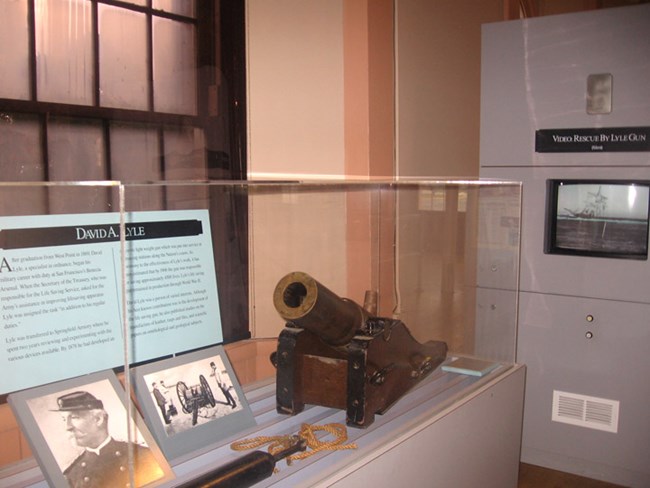
Springfield Armory NHS, US NPS David A. Lyle After graduation from West Point in 1869, David Lyle, a specialist in ordnance, began his military career with duty at San Francisco’s Benecia Arsenal. When the Secretary of the Treasury, who was responsible for the Life Saving Service, asked for the Army’s assistance in improving lifesaving apparatus, Lyle was assigned the task “in addition to his regular duties.” Lyle transferred to Springfield Armory where he spent two years reviewing and experimenting with the various devices available. By 1878 he had developed an accurate light weight gun which was put into service at lifesaving stations along the Nation’s coasts. As testimony to the effectiveness of Lyle’s work, it has been estimated that by 1906 the gun was responsible for saving approximately 4500 lives. Lyle’s life saving gun remained in production through World War II. David Lyle was a person of varied interests. Although his best known contribution was the development of the life saving gun, he also published studies on the manufacture of leather, rasps and files, and scientific papers on ornithological and geological subjects.

Life Saving" Gun Springfield Armory NHS archives, US NPS 
Ships running aground in heavy seas could be lost within sight of safety, with the wild surf making rescue by small craft impossible. Soon after Congress authorized a Federal agency to operate coastal facilities in 1871, attention turned to making improvements in lifesaving apparatus. Assigned to this task, ordnance officer David A. Lyle developed a small cannon that shot a projectile, to which a light line was attached, to a stranded vessel. The ship’s crew pulled progressively heavier lines from shore or another ship; then a breeches buoy suspended from a rope carried one person at a time from the ship to safety. Springfield Armory NHS, US NPS 
Courtesy: Leib Image Archive, York, PA [#PC131004] 
Courtesy: Madison Bay Company, East Berlin, PA [#PC136502] 
The Life Line, by Winslow Homer, 
During the great 1936 flood, when the Connecticut River flooded Springfield and communities throughout the valley, the Lyle Lifesaving Gun helped establish communications by throwing lines to pull phone line across the swollen rivers, as recorded at the time in this local newspaper article. Springfield Republican newspaper, 1936 
In this newspaper image from nearly seventy years after the 1936 flood, the Lyle Lifesaving Gun still booms. In this case, it is seen during an intensive PArk Ranger training program in its use by the US National Park Service. The Lyle gun is demonstrated weekly each summer at Race Point by the US NPS on Cape Cod National Sea Shore. Cape Cod Times newspaper, June 24, 2005 |
Last updated: February 26, 2015
